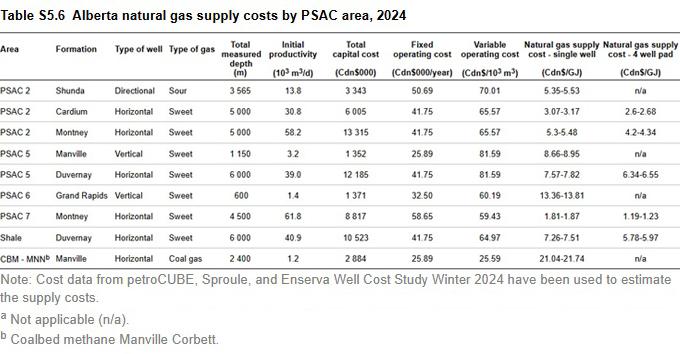Updated June 2025
The supply cost of a resource project is the minimum constant dollar price needed to recover all capital expenditures, operating costs, royalties, taxes, and earn a specified return on investment. Supply costs indicate whether a project is economically viable and are interpreted as the value required per unit of production.
Understanding the underlying geology allows the most effective and cost-efficient completion technology to be used. The supply cost for different geological plays and Petroleum Services Association of Canada (PSAC) areas varies significantly because of differing
- production rates,
- natural gas liquids content in the gas,
- well types,
- drilling and operating costs, and
- royalties.
Wells with a longer total measured depth, typically horizontal wells, tend to have higher initial productivity and capital costs. However, the high initial productivity of these wells will generally offset high capital costs, leading to lower supply costs.
Typically, wells that target liquids-rich gas have lower supply costs. As a by-product, liquids add to revenues, offsetting the costs of a well. Wells targeting liquids-rich gas are mainly in
- Foothills Front (PSAC area 2),
- Central Alberta (PSAC area 5), and
- Northwestern Alberta (PSAC area 7).
Supply Costs by PSAC Area
Table S5.6 shows the estimated costs for gas, shale, and coalbed methane natural gas wells by PSAC area based on 2024 capital and operating costs and production profiles. Operators often drill multiple wells from a well pad, referred to as a multiwell pad. These wells benefit from economies of scale and usually incur lower capital costs, resulting in a lower cost per unit of output. Supply costs are lowest for horizontal wells in the Foothills Front and Northwestern Alberta areas (PSAC areas 2 and 7).
Recompletions were not considered in the analysis. They are substantially cheaper than new drills but have weaker initial productivity rates.
Most areas of Alberta experienced increased natural gas supply costs in 2024, mainly due to increased capital and operating costs. According to the latest PSAC well cost study, drilling and completion costs for gas wells in Alberta were, on average, 1.5% higher than in 2023. North American upstream operating costs were estimated to be 1.5% higher in 2024 compared with 2023. Production of natural gas liquids helped with the economics of natural gas wells and supply costs.
One-Year Tariff Scenario (Tariff Case)
Natural gas supply costs are expected to be slightly higher than the base case. Increased production costs, particularly drilling and completion, will affect supply costs.
Due to the tariffs imposed by the U.S. on Canadian oil and gas exports and Canadian retaliatory tariffs, supply cost ranges in Table S5.6 have been included, which include an upper and lower bound. The lower bound represents the base case cost estimates, and the upper bound is the tariff case-adjusted cost estimates. Tariffs are assumed to last one year, increasing the costs of key oil and gas drilling and production inputs.



